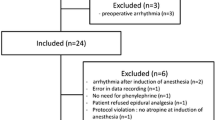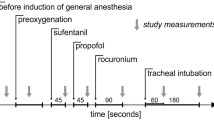Abstract
This study was carried out to evaluate the effects of fentanyl on cardiovascular and catecholamine responses during rapid sequence induction (RSI) in hypertensive patients. Twenty-eight patients were allocated into one of 3 groups: group 1 (n=7) consisted of normotensive patients receiving no fentanyl, group 2 (n=10) consisted of normotensive patients receiving fentanyl, and group 3 (n=11) consisted of hypertensive patients receiving fentanyl. RSI was performed with thiamylal (4mg·kg−1) and succinylcholine (2mg·kg−1) for all groups. In groups 2 and 3, fentanyl (4 μg·kg−1) was given prior to induction. Measurements including systolic arterial pressure (SAP) and heart rate (HR) were made at preinduction (T1), preintubation (T2), 1 min after intubation (T3), and 3 min after intubation (T4). Simultaneously, plasma concentrations of epinephrine (E) and norepinephrine (NE) were measured at T1 and T3. Group 1 showed significant increases in SAP, HR, and NE at T3 as compared to T1. Group 2 showed a significant increase in HR at T3 but not in SAP or catecholamines. Group 3 showed no increase in SAP, HR, or catecholamines throughout the time course. The results suggest that fentanyl is useful to suppress sympathoadrenal and cardiovascular responses to RSI in hypertensive patients as well as normotensive patients.
Similar content being viewed by others
References
Selick BA (1961) Cricoid pressure to control regurgitation of stomach contents during induction of anaesthesia. Lancet 2:404–406
Brown JA, Foster SD, Anderson CT, Saltzman JA (1991) The literature and perspectives on muscle relaxants for rapid sequence induction. Nurse Anesth 2:72–88
Chraemmer JB, Hoilund CP, Marving J, Christensen V (1986) Left ventricular ejection fraction during anaesthetic induction: comparison of rapid-sequence and elective induction. Can Anaesth Soc J 33:754–759
Randall CC, Juli W, Stuart RH, John B (1983) Pre-treatment with low-dose fentanyl for rapid-sequence intubation. Anesthesiology 59:A344
Chraemmer JB, Hoilund CP, Bjerre JK, Hertel S, Marving J, Strom J, Damkjaer NM, Lonborg JH, Hjort JB (1992) Does alfentanil preserve left ventricular pump function during rapid sequence induction of anaesthesia? Acta Anaesthesiol Scand 36:362–368
Mikawa K, Maekawa N, Kaetsu H, Goto R, Yaku H, Obara H (1991) Effects of adenosine triphosphate on the cardiovascular response to tracheal intubation. Br J Anaesth 67:410–415
Martineau RJ, Tousignant CP, Miller DR, Hull KA (1990) Alfentanil controls the haemodynamic response during rapid-sequence induction of anaesthesia. Can J Anaesth 37:755–761
Tomiyasu S, Furuta K, Shibata S, Ide R, Niiya S, Shibata O (1992) The effects of midazolam and fentanyl on circulatory, respiratory and humoral responses in rapid sequence anesthetic induction and tracheal intubation (in Japanese with English abstract). Rinshou Masui (J Clin Anesth) 12:731–737
Yui Y, Kimura M, Itokawa Y, Kawai C (1979) Ultramicro method for the determination of picogram amounts of norepinephrine and epinephrine by high-performance liquid chromatography. J Chromatogr 177:376–379
Manager WM, Frohlich ED, Gifford RW, Dustan HP (1976) Norepinephrine infusion in normal subjects and patients with essential or renal hypertension: effect on blood pressure, heart rate, and plasma catecholamine concentrations. J Clin Pharmacol 16:129–141
Chobanian AV, Garvras H, Garvras I, Bresnahan M, Sullivan P, Melby JC (1978) Studies on the activity of the sympathetic nervous system in essential hypertension. J Hum Stress 4:22–28
Schutz W, Hortnagl H, Magometschnigg D (1986) Function of the autonomic nervous system in young, untreated hypertensive patients. Int J Cardiol 10:133–140
Low JM, Harvey JT, Roverts CP, Dangnino J (1986) Studies of anaesthesia in relation to hypertension. VH: Adrenergic responses to laryngoscopy. Br J Anaesth 58:471–477
Goldstein DS (1983) Plasma catecholamines and essential hypertension. An analytical review. Hypertension 5:86–99
Kjeldsen SE, Flaaten B, Eide I, Helgeland A, Leren P (1982) Evidence of increased peripheral catecholamine release in patients with long-standing untreated essential hypertension. Scand J Clin Lab Invest 42:217–223
Takino Y, Kaneda T, Morisaki H (1990) Plasma catecholamine response to tracheal intubation after midazolam and vecuronium in elderly patients with hypertension (in Japanese with English abstract). Masui (Jpn J Anesthesiol) 39:1669–1672
Author information
Authors and Affiliations
About this article
Cite this article
Matsumoto, M., Fukusaki, M., Iwanaga, S. et al. Effects of fentanyl on cardiovascular response during rapid sequence induction in hypertensive patients. J Anesth 11, 10–13 (1997). https://doi.org/10.1007/BF02479997
Received:
Accepted:
Issue Date:
DOI: https://doi.org/10.1007/BF02479997




